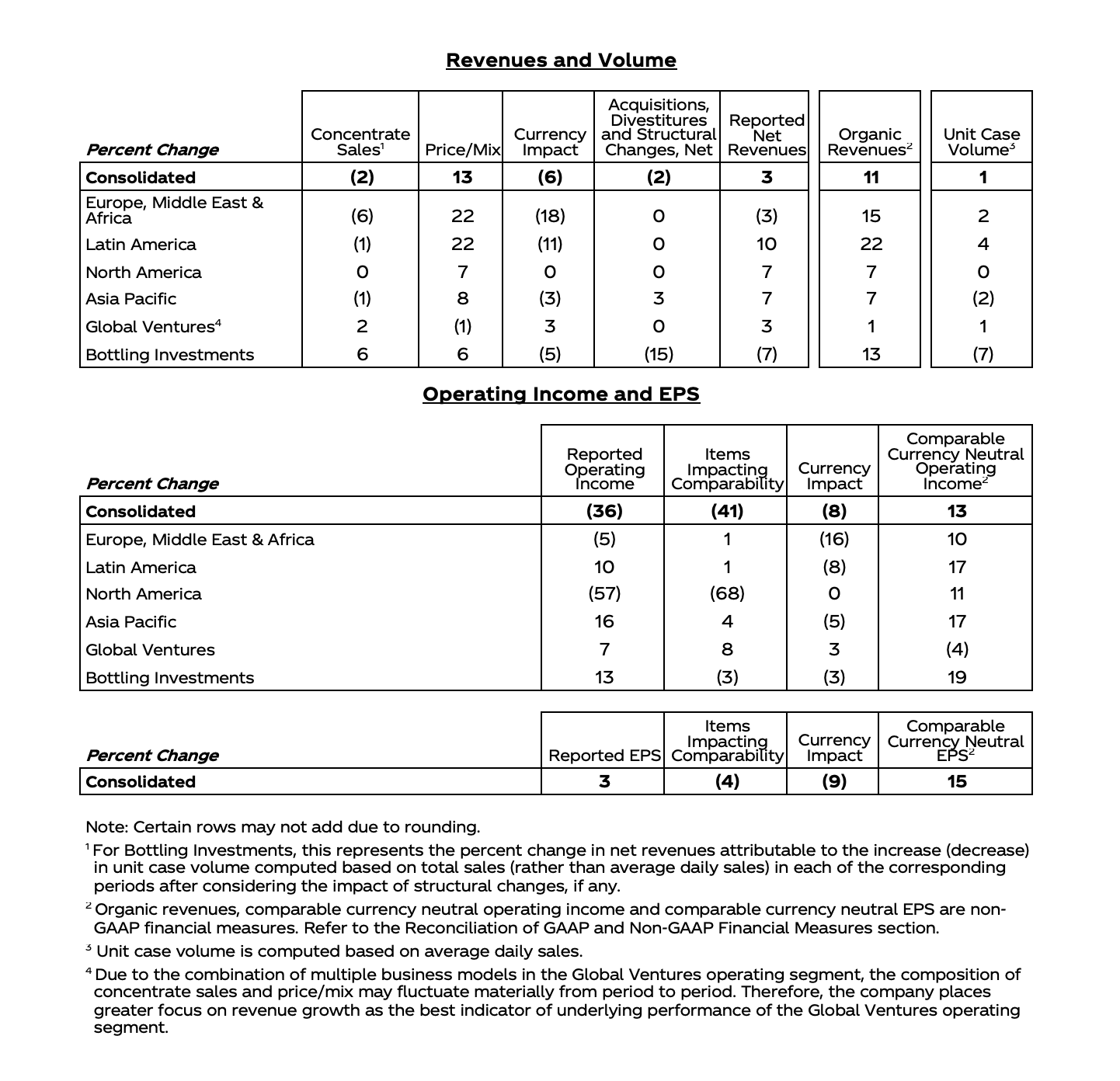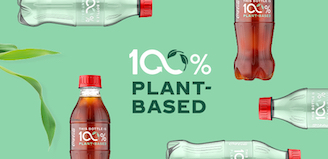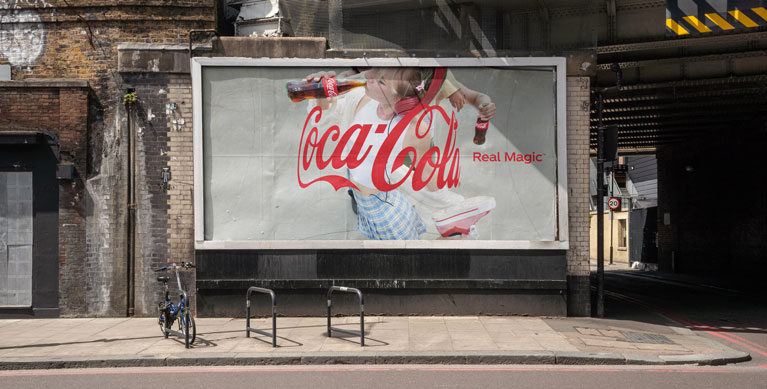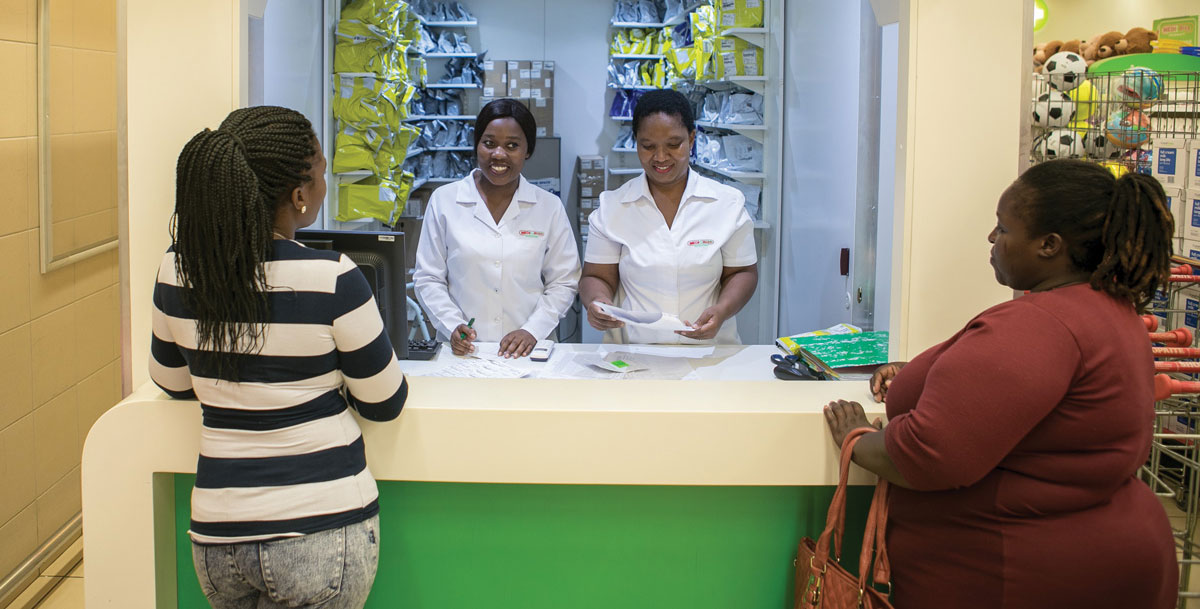Coca‑Cola Reports First Quarter 2024 Results and Provides Updated Guidance
04-30-2024
Global Unit Case Volume Grew 1%
Net Revenues Grew 3%;
Organic Revenues (Non-GAAP) Grew 11%
Operating Income Declined 36%;
Comparable Currency Neutral Operating Income (Non-GAAP) Grew 13%
Operating Margin Was 18.9% Versus 30.7% in the Prior Year;
Comparable Operating Margin (Non-GAAP) Was 32.4% Versus 31.8% in the Prior Year
EPS Grew 3% to $0.74; Comparable EPS (Non-GAAP) Grew 7% to $0.72
ATLANTA, April 30, 2024 – The Coca‑Cola Company today reported first quarter 2024 results. “We’re encouraged by our start to 2024, delivering another quarter of volume, topline and earnings growth amidst a dynamic backdrop,” said James Quincey, Chairman and CEO of The Coca‑Cola Company. “We believe our global system is primed for sustained success, thanks to the right strategies, clear alignment, a powerful portfolio and strong execution.”
Highlights
Quarterly Performance
- Revenues: Net revenues grew 3% to $11.3 billion, and organic revenues (non-GAAP) grew 11%. Revenue performance included 13% growth in price/mix and a 2% decline in concentrate sales. Concentrate sales were 3 points behind unit case volume, largely due to the timing of concentrate shipments and the impact of one less day in the quarter.
- Operating margin: Operating margin was 18.9% versus 30.7% in the prior year, while comparable operating margin (non-GAAP) was 32.4% versus 31.8% in the prior year. The operating margin decline was driven by items impacting comparability, including a charge of $765 million related to the remeasurement of our contingent consideration liability to fair value in conjunction with our acquisition of fairlife, LLC (“fairlife”) in 2020 and a non-cash impairment charge of $760 million related to the BODYARMOR trademark, as well as currency headwinds. Comparable operating margin (non-GAAP) expansion was primarily driven by the impact of refranchising bottling operations and strong topline growth, partially offset by currency headwinds and an increase in marketing investments.
- Earnings per share: EPS grew 3% to $0.74, while comparable EPS (non-GAAP) grew 7% to $0.72. EPS performance included the impact of a 7-point currency headwind, while comparable EPS (non-GAAP) performance included the impact of a 9-point currency headwind.
- Market share: The company gained value share in total nonalcoholic ready-to-drink (NARTD) beverages.
- Cash flow: Cash flow from operations was $528 million, an increase of $368 million versus the prior year, driven by strong business performance and working capital initiatives, partially offset by currency headwinds. Free cash flow (non-GAAP) was $158 million, an increase of $274 million versus the prior year.
Company Updates
- Trademark Coca‑Cola led growth supported by broad innovation: With consumers increasing their engagement across various social media platforms, the company launched Coca‑Cola Happy Tears Zero Sugar, its first product sold exclusively on social media in the United States and Great Britain. Building on the Coke Creations platform, Happy Tears reached consumers with a limited-edition beverage inspired by tears of joy from small acts of kindness. “Hype kits” containing Coca‑Cola Happy Tears Zero Sugar and kindness-themed accessories sold out in less than 24 hours and garnered more than 2 billion impressions. In the quarter, the company also introduced Foodmarks by Coca‑Cola — as part of the “Recipe for Magic” platform — in over 4,000 locations worldwide. To drive excitement, unique dining experiences were created that pair Coke with meals and local culture. In Thailand, legendary restaurants were transformed into Foodmarks, celebrating street food, music and Coca‑Cola. This kind of marketing, which connects consumption occasions with live experiences and consumer passion points, contributed to Trademark Coca‑Cola value share gains and volume growth ahead of total company growth. The company also continued to meet consumers’ evolving needs by extending offerings and distribution with affordable and premium packages. In Africa, packages at affordable price points, such as returnable glass and plastic, grew volume double digits for the second consecutive quarter. In the United States, the company continued to expand mini-can availability through mini-can variety packs in the club channel.
- Continuing to drive digital capabilities: The company continued to leverage digital tools to deepen end-to-end relationships with consumers and customers. For example, the company used scannable codes on its packaging to engage consumers, collect first-party data and drive transactions. In the first quarter, there were over 200 active connected packs in more than 40 global markets offering exclusive personalized experiences to consumers. Additionally, the company and its bottling partners continue to invest in digitizing their customer base by integrating fragmented trade customers into B2B platforms. In the first quarter, there was an 8% increase of connected customers compared to the prior year, reaching nearly 8 million customers on B2B platforms. The company continues to utilize the power of AI, as AI-enabled suggested orders are fueling growth. In Latin America, suggested order capabilities have benefited over 3 million outlets, while in India, retailers are leveraging AI-powered suggested order recommendations on Coke Buddy, a customer engagement platform, to place bulk orders via the app. At the shopper level, digital capabilities enabled bottling partners to personalize point-of-sale messaging and drive basket incidence more effectively and efficiently. In Japan’s vending channel, the Coke On app has reached over 50 million downloads and accounts for more than 1 million transactions per day.
Operating Review – Three Months Ended March 29, 2024

In addition to the data in the preceding tables, operating results included the following:
Consolidated
- Unit case volume grew 1%. Developed markets were even, while developing and emerging markets grew low single digits, driven by growth in Brazil, the Philippines and Nigeria.
Unit case volume performance included the following:
- Sparkling soft drinks grew 2%, led by strong performance in Latin America. Trademark Coca‑Cola grew 2%, driven by growth in Latin America, Asia Pacific and North America. Coca‑Cola Zero Sugar grew 6%, driven by growth in Latin America, Europe, Middle East and Africa, and North America. Sparkling flavors were even, as growth in Europe, Middle East and Africa and Latin America was offset by a decline in Asia Pacific.
- Juice, value-added dairy and plant-based beverages grew 2%, led by North America.
- Water, sports, coffee and tea declined 2%. Water declined 2%, driven by Asia Pacific and North America. Sports drinks declined 3%, as growth in Latin America and Europe, Middle East and Africa was more than offset by a decline in North America. Coffee declined 3%, primarily due to the performance of Costa coffee in the United Kingdom. Tea grew 2%, driven by growth in Europe, Middle East and Africa and Latin America.
- Price/mix grew 13%. Approximately 6 points were driven by pricing from markets experiencing intense inflation, with the remainder driven by pricing actions in the marketplace and favorable mix. Concentrate sales were 3 points behind unit case volume, primarily due to the timing of concentrate shipments as well as the impact of one less day in the quarter.
- Operating income declined 36%, driven by items impacting comparability, including a charge of $765 million related to the remeasurement of our contingent consideration liability to fair value in conjunction with our acquisition of fairlife and a non-cash impairment charge of $760 million related to the BODYARMOR trademark, as well as currency headwinds. Comparable currency neutral operating income (non-GAAP) grew 13%. Performance was driven by organic revenue (non-GAAP) growth across all operating segments, partially offset by an increase in marketing investments.
Europe, Middle East & Africa
- Unit case volume grew 2%, driven by growth in water, sports, coffee and tea as well as sparkling flavors. Growth was led by Nigeria, Germany and South Africa.
- Price/mix grew 22%. Approximately two-thirds was driven by pricing from markets experiencing intense inflation, with the remainder driven primarily by pricing actions across operating units. Concentrate sales were 8 points behind unit case volume, primarily due to the timing of concentrate shipments as well as the impact of one less day in the quarter.
- Operating income declined 5%, which included a 15-point currency headwind and items impacting comparability. Comparable currency neutral operating income (non-GAAP) grew 10%, primarily driven by strong organic revenue (non-GAAP) growth, partially offset by higher operating expenses and an increase in marketing investments.
- The company gained value share in total NARTD beverages, led by share gains in Nigeria, South Africa and France.
Latin America
- Unit case volume grew 4%, driven by growth in Trademark Coca‑Cola and water, sports, coffee and tea. Growth was led by Brazil and Mexico.
- Price/mix grew 22%. Approximately three-fourths was driven by the impact of inflationary pricing in Argentina, with the remainder driven by pricing actions in the marketplace, partially offset by category mix. Concentrate sales were 5 points behind unit case volume, primarily due to the timing of concentrate shipments and one less day in the quarter.
- Operating income grew 10%, which included a 7-point currency headwind and items impacting comparability. Comparable currency neutral operating income (non-GAAP) grew 17%, primarily driven by strong organic revenue (non-GAAP) growth, partially offset by an increase in marketing investments.
- The company lost value share in total NARTD beverages, as share gains in Mexico, Colombia and Ecuador were more than offset by losses in Argentina, Chile and Brazil.
North America
- Unit case volume was even as growth in juice, value-added dairy and plant-based beverages and Trademark Coca‑Cola was offset by a decline in water, sports, coffee and tea.
- Price/mix grew 7%, driven by pricing actions in the marketplace and favorable category mix. Concentrate sales were in line with unit case volume.
- Operating income declined 57% for the quarter, driven by items impacting comparability, including a non-cash impairment charge of $760 million related to the BODYARMOR trademark. Comparable currency neutral operating income (non-GAAP) grew 11%, primarily driven by organic revenue (non-GAAP) growth.
- The company gained value share in total NARTD beverages, driven by sparkling soft drinks, value-added dairy, juice and water.
Asia Pacific
- Unit case volume declined 2%, as growth in Trademark Coca‑Cola and juice, value-added dairy and plant-based beverages was more than offset by a decline in water, sports, coffee and tea. Growth in the Philippines, India, Vietnam and Indonesia was more than offset by a decline in China.
- Price/mix grew 8%, primarily driven by favorable category mix and pricing actions in the marketplace. Concentrate sales were 1 point ahead of unit case volume, primarily due to the timing of concentrate shipments.
- Operating income grew 16%, which included items impacting comparability. Comparable currency neutral operating income (non-GAAP) grew 17%, driven by organic revenue (non-GAAP) growth, partially offset by an increase in marketing investments.
- The company gained value share in total NARTD beverages, led by share gains in the Philippines, South Korea and Japan.
Global Ventures
- Net revenues grew 3%, and organic revenues (non-GAAP) grew 1%.
- Operating income grew 7%, which included items impacting comparability and a 3-point currency tailwind. Comparable currency neutral operating income (non-GAAP) declined 4%, driven by an increase in operating expenses and marketing investments.
Bottling Investments
- Unit case volume declined 7%, as growth in South Africa was more than offset by the impact of refranchising bottling operations.
- Price/mix grew 6%, driven by pricing actions across most markets as well as favorable mix.
- Operating income grew 13%, which included items impacting comparability and a 3-point currency headwind. Comparable currency neutral operating income (non-GAAP) grew 19%, driven by organic revenue (non-GAAP) growth, partially offset by higher operating expenses.
Outlook
The 2024 outlook information provided below includes forward-looking non-GAAP financial measures, which management uses in measuring performance. The company is not able to reconcile full-year 2024 projected organic revenues (non-GAAP) to full-year 2024 projected reported net revenues, full-year 2024 projected comparable net revenues (non-GAAP) to full-year 2024 projected reported net revenues, full-year 2024 projected underlying effective tax rate (non-GAAP) to full-year 2024 projected reported effective tax rate, full-year 2024 projected comparable currency neutral EPS (non-GAAP) to full-year 2024 projected reported EPS, or full-year 2024 projected comparable EPS (non-GAAP) to full-year 2024 projected reported EPS without unreasonable efforts because it is not possible to predict with a reasonable degree of certainty the exact timing and exact impact of acquisitions, divestitures and structural changes throughout 2024; the exact timing and exact amount of items impacting comparability throughout 2024; and the exact impact of fluctuations in foreign currency exchange rates throughout 2024. The unavailable information could have a significant impact on the company’s full-year 2024 reported financial results.
Full Year 2024
The company expects to deliver organic revenue (non-GAAP) growth of 8% to 9%, which consists of operating performance at the high end of the company’s long-term growth model and the anticipated pricing impact of a number of markets experiencing intense inflation. — Updated
For comparable net revenues (non-GAAP), the company expects a 4% to 5% currency headwind based on the current rates and including the impact of hedged positions. Comparable EPS (non-GAAP) percentage growth is expected to include a 7% to 8% currency headwind based on the current rates and including the impact of hedged positions. The majority of currency headwinds are due to currency devaluation resulting from intense inflation. —Updated
For comparable net revenues (non-GAAP), the company expects a 4% to 5% headwind from acquisitions, divestitures and structural changes. Comparable EPS (non-GAAP) is expected to include an approximate 2% headwind from acquisitions, divestitures and structural changes. — No Update
The company’s underlying effective tax rate (non-GAAP) is estimated to be 19.0%. This does not include the impact of ongoing tax litigation with the U.S. Internal Revenue Service, if the company were not to prevail. — Updated
The company expects to deliver comparable currency neutral EPS (non-GAAP) growth of 11% to 13%. — Updated
The company expects comparable EPS (non-GAAP) growth of 4% to 5%, versus $2.69 in 2023. — No Update
The company expects to generate free cash flow (non-GAAP) of approximately $9.2 billion through cash flow from operations of approximately $11.4 billion, less capital expenditures of approximately $2.2 billion. This does not include any potential payments related to ongoing tax litigation with the IRS. — No Update
Second Quarter 2024 Considerations — New
Comparable net revenues (non-GAAP) are expected to include an approximate 6% currency headwind based on the current rates and including the impact of hedged positions, in addition to an approximate 5% to 6% headwind from acquisitions, divestitures and structural changes.
Comparable EPS (non-GAAP) percentage growth is expected to include an approximate 8% to 9% currency headwind based on the current rates and including the impact of hedged positions, in addition to an approximate 2% headwind from acquisitions, divestitures and structural changes.
Notes
- All references to growth rate percentages and share compare the results of the period to those of the prior year comparable period, unless otherwise noted.
- All references to volume and volume percentage changes indicate unit case volume, unless otherwise noted. All volume percentage changes are computed based on average daily sales, unless otherwise noted. “Unit case” means a unit of measurement equal to 192 U.S. fluid ounces of finished beverage (24 eight-ounce servings), with the exception of unit case equivalents for Costa non-ready-to-drink beverage products which are primarily measured in number of transactions. “Unit case volume” means the number of unit cases (or unit case equivalents) of company beverages directly or indirectly sold by the company and its bottling partners to customers or consumers.
- “Concentrate sales” represents the amount of concentrates, syrups, beverage bases, source waters and powders/minerals (in all instances expressed in unit case equivalents) sold by, or used in finished beverages sold by, the company to its bottling partners or other customers. For Costa non-ready-to-drink beverage products, “concentrate sales” represents the amount of beverages, primarily measured in number of transactions (in all instances expressed in unit case equivalents) sold by the company to customers or consumers. In the reconciliation of reported net revenues, “concentrate sales” represents the percent change in net revenues attributable to the increase (decrease) in concentrate sales volume for the geographic operating segments and the Global Ventures operating segment after considering the impact of structural changes, if any. For the Bottling Investments operating segment, this represents the percent change in net revenues attributable to the increase (decrease) in unit case volume computed based on total sales (rather than average daily sales) in each of the corresponding periods after considering the impact of structural changes, if any. The Bottling Investments operating segment reflects unit case volume growth for consolidated bottlers only.
- “Price/mix” represents the change in net operating revenues caused by factors such as price changes, the mix of products and packages sold, and the mix of channels and geographic territories where the sales occurred.
- First quarter 2024 financial results were impacted by one less day as compared to first quarter 2023, and fourth quarter 2024 financial results will be impacted by two additional days as compared to fourth quarter 2023. Unit case volume results for the quarters are not impacted by the variances in days due to the average daily sales computation referenced above.
Conference Call
The company is hosting a conference call with investors and analysts to discuss first quarter operating results today, April 30, 2024, at 8:30 a.m. ET. The company invites participants to listen to a live webcast of the conference call on the company’s website, http://www.coca-colacompany.com, in the “Investors” section. An audio replay in downloadable digital format and a transcript of the call will be available on the website within 24 hours following the call. Further, the “Investors” section of the website includes certain supplemental information and a reconciliation of non-GAAP financial measures to the company’s results as reported under GAAP, which may be used during the call when discussing financial results.
Forward-Looking Statements
This press release may contain statements, estimates or projections that constitute “forward-looking statements” as defined under U.S. federal securities laws. Generally, the words “believe,” “expect,” “intend,” “estimate,” “anticipate,” “project,” “will” and similar expressions identify forward-looking statements, which generally are not historical in nature. Forward-looking statements are subject to certain risks and uncertainties that could cause The Coca‑Cola Company’s actual results to differ materially from its historical experience and our present expectations or projections. These risks include, but are not limited to, unfavorable economic and geopolitical conditions, including the direct or indirect negative impacts of the conflict between Russia and Ukraine and conflicts in the Middle East; increased competition; an inability to be successful in our innovation activities; changes in the retail landscape or the loss of key retail or foodservice customers; an inability to expand our business in emerging and developing markets; an inability to successfully manage the potential negative consequences of our productivity initiatives; an inability to attract or retain a highly skilled and diverse workforce; disruption of our supply chain, including increased commodity, raw material, packaging, energy, transportation and other input costs; an inability to successfully integrate and manage our acquired businesses, brands or bottling operations or an inability to realize a significant portion of the anticipated benefits of our joint ventures or strategic relationships; failure by our third-party service providers and business partners to satisfactorily fulfill their commitments and responsibilities; an inability to renew collective bargaining agreements on satisfactory terms, or we or our bottling partners experience strikes, work stoppages, labor shortages or labor unrest; obesity and other health-related concerns; evolving consumer product and shopping preferences; product safety and quality concerns; perceived negative health consequences of certain ingredients, such as non-nutritive sweeteners and biotechnology-derived substances, and of other substances present in our beverage products or packaging materials; failure to digitalize the Coca‑Cola system; damage to our brand image, corporate reputation and social license to operate from negative publicity, whether or not warranted, concerning product safety or quality, workplace and human rights, obesity or other issues; an inability to successfully manage new product launches; an inability to maintain good relationships with our bottling partners; deterioration in our bottling partners’ financial condition; an inability to successfully manage our refranchising activities; increases in income tax rates, changes in income tax laws or the unfavorable resolution of tax matters, including the outcome of our ongoing tax dispute or any related disputes with the U.S. Internal Revenue Service (“IRS”); the possibility that the assumptions used to calculate our estimated aggregate incremental tax and interest liability related to the potential unfavorable outcome of the ongoing tax dispute with the IRS could significantly change; increased or new indirect taxes; changes in laws and regulations relating to beverage containers and packaging; significant additional labeling or warning requirements or limitations on the marketing or sale of our products; litigation or legal proceedings; conducting business in markets with high-risk legal compliance environments; failure to adequately protect, or disputes relating to, trademarks, formulas and other intellectual property rights; changes in, or failure to comply with, the laws and regulations applicable to our products or our business operations; fluctuations in foreign currency exchange rates; interest rate increases; an inability to achieve our overall long-term growth objectives; default by or failure of one or more of our counterparty financial institutions; impairment charges, and risks regarding potential additional impairments; an inability to protect our information systems against service interruption, misappropriation of data or cybersecurity incidents; failure to comply with privacy and data protection laws; evolving sustainability regulatory requirements and expectations; increasing concerns about the environmental impact of plastic bottles and other packaging materials; water scarcity and poor quality; increased demand for food products, decreased agricultural productivity and increased regulation of ingredient sourcing due diligence; climate change and legal or regulatory responses thereto; adverse weather conditions; and other risks discussed in our filings with the Securities and Exchange Commission (“SEC”), including our Annual Report on Form 10-K for the year ended December 31, 2023, which filings are available from the SEC. You should not place undue reliance on forward-looking statements, which speak only as of the date they are made. We undertake no obligation to publicly update or revise any forward-looking statements.


